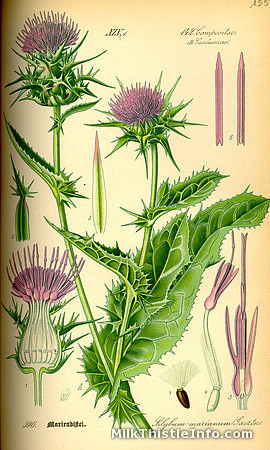

The therapeutic properties of milk thistle have been appreciated for over 2000 years. Already in the 1st century a military physician Pedanios Dioskurides recommended the root of the plant with drinking honey as a medicine for vomiting, and noted that the root cooked with oil and salt is a tasty vegetable. Gaius Plinius Secundus also mentions the cholagogic effect of the plant.1
In the Middle Ages, Hildegard of Bingen recommended milk thistle for piercing pains in the chest – which corresponds to contemporary definition of pneumonia and pleuritis. It was recognised that the root had water-draining properties and stimulated milk secretion.1
An Italian physician Matthioli in the 16th century prescribed milk thistle root for “jaundice, nephrolithiasis and obstructed liver”.2
In the 18th century, milk thistle was also used for liver conditions.1 In the Middle Europe, and especially in Prussia, the plant was cultured already in 17th and 18th century.3
In the middle 19th century, milk thistle was used for hepatic diseases, as well as for flatulence, constipation and haemorrhoids.1 FThe fruit was commonly used for therapy, but in the beginning of the 20th century their importance dropped. When sylimarin was discovered in fruit extracts, and its protective effect on the liver was confirmed in scientific trials, the role of milk thistle in therapy was reinstated.
American Eclectics use a seed tincture for lack of menstruation, bleeding, dysuria (difficulties with urination), gall stones, hyperaemia, haematuria, liver diseases, chronic vomiting and nephrotic syndrome.
The Basques use a seed decoction as an anti-inflammatory, anti-cancer, purgatory, diuretic agent, and for improvement of digestion, bleeding stopping, blood pressure reduction.
The Germans use it as a soothing agent for rhinitis and for pleuritis, jaundice and biliary disorders.
The Lebanese recognise a flower infusion as a retuning agent, lowering high fever and tonifying.
They also use a seed infusion for gall stones and liver problems, as an agent stimulating milk production, activating and tonifying.
Inhabitants of North Africa use a seed tincture for coughs, peritonitis, pneumonia, bronchitis and varicose veins.
The Turkish use decoction of milled and roasted seeds on dyspnoea associated with bronchial diseases.
References: